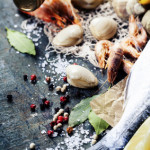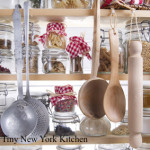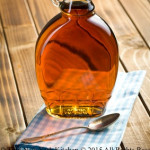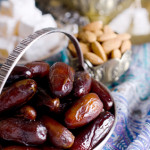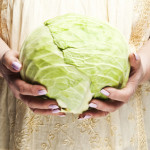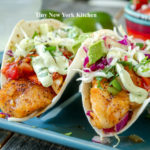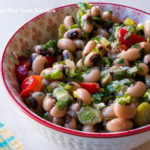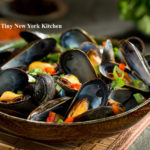I love making these grilled cheese sandwiches. I used champagne cheese from Yancey’s Fancy Cheese.
Seafood
Keep your seafood fresh with safe handling and cooking tips.
Selecting Seafood
The first step in putting the best seafood on your plate is making sure that you put the best seafood in your shopping cart. Make the best choices at the store and you’ll enjoy great taste at the table every time.
When you’re shopping, make seafood the very last thing you pick up before you check out. Make sure to place it in an insulated bag for your trip home.
When purchasing clams and oysters in their shells, make sure they are alive. Shells of live clams and oysters may open naturally, but will close tightly when tapped, indicating that they are alive. Throw away any dead ones.
Fresh whole fish should have a shiny surface with tightly adhering scales, gills that are deep red or pink, free of slime, mucus and off-odor, and milk, briny aroma, similar to the ocean.
Fresh steaks, fillets, and loins should have a translucent look, fresh that is firm and not separating and a mild briny odor, similar to the ocean.
Handling Seafood
Shore to store is only one leg of the journey. It’s important to continue following safe handling recommendations once you take your seafood purchase home.
If your seafood is frozen make sure to thaw seafood in the refrigerator. Never thaw at room temperature.
Wash your hands with hot soapy water before and after handling raw seafood.
Thoroughly wash containers that held raw seafood before using them again.
Cooking Seafood
Now that your seafood is home safely, it’s time to get cooking.
Make sure that you cook fresh fillets and shellfish 1 to 2 days after purchasing.
Keep seafood refrigerated until it’s time to cook.
A general rule for baking and broiling fish is 10 minutes per inch of thickness at 400 to 450 degrees.
Fish is done when the flesh becomes opaque and flakes easily at the thickest part.
Scallops, clams, oysters, and shrimp become opaque and firm when fully cooked. Don’t overcook as this will result in loss of moisture, which affects texture and taste.
To boil, place shrimp and scallops in a large pot of boiling water (four cups of water per pound of meat) and simmer three to five minutes.
Broiled scallops and peeled and deveined shrimp will be cooked in 3 to 5 minutes.
Broiled shucked clams and oysters will be cooked in 3 to 5 minutes.
Oysters and clams should be steamed until their shells open completely. Throw away any that do not open.
Most seafood should be cooked to an internal temperature of 145 degrees. Consuming raw or undercooked seafood or shellfish may increase your risk of foodborne illness, especially if you have a medical condition.
“Work With What You Got!”
© Victoria Hart Glavin Tiny New York Kitchen © 2016 All Rights Reserved
Lunar New Year 2016
This year, the Lunar New Year will begin on Monday, February 8. It is the biggest event of the year for Chinese people and Chinese emigrants throughout the world. Although there are various styles of celebrating the Lunar New Year, the spirit behind these celebrations is the same. The beginning of the New Year marks a time for a fresh start, so people try to clean up everything completely and tie up loose ends before the end of the previous year. On New Year’s Day, people wear new clothes. This day people also pay their respects to their ancestors, so it is a family reunion day rather than a day for dining out and partying. Families go to temples to pray for deceased family members and offer them special Near Year foods.
The symbolic color of the Lunar New Year is red. Streets and houses are decorated with red ornaments bearing the characters for happiness, prosperity, peace, and spring, among others. Chinese communities literally turn red. Kids receive money from relatives in red envelopes known as hong bao.
Lunar New Year parades attract many spectators, not only those of Chinese descent, but also people outside the Chinese community. The lion dance (not a dragon dance) is the main performance of the parade. The traditional dance is based on a Chinese myth about people successfully driving away monsters. The dance has evolved as the Chinese diaspora has spread throughout the world. There are two main versions: the northern lion dance and the southern lion dance, and the latter is seen more often in the world because more Chinese immigrants are from the southern regions of China.
Firecrackers also enhance the excitement of the parade. You may think firecrackers for the Lunar New Year are too noisy and perhaps scary, but these are meant to drive away evil spirits, so they should be scary! Many people are willing to endure that noise once a year in hopes of staying away from misfortune the rest of the year.
The Lunar New Year celebration culminates with the Lantern Festival on the fifteenth day of the first month in the lunar calendar, which is the first full moon of that lunisolar year. During the event, countless lanterns are hung, decorating temples and streets at night. There are several legends associated with the festival, but the lanterns are almost always red, the color of good fortune.
Lunar New Year cuisine also differs from place to place, although there are some significant similarities. People in most regions eat something wrapped and stuffed (dumplings, spring rolls, banana leaf–or bamboo skin–wrapped sticky rice), something long (noodles), and money-like fruits (tangerines and oranges). Fillings, toppings, and sizes vary depending on the culture, but all foods symbolize good things like abundance, longevity, and prosperity. Whole fish is also symbolic main dish in most Lunar New Year celebrations.
Japanese people celebrate the first day of the New Year as well, but in a very different way. Called Setsubun, the celebration is accompanied by a special ritual of throwing beans to clean away all the evil of the former year in the lunar calendar and drive away disease-bringing evil spirits from the year to come. Roasted soybeans are thrown either out the door or at a member of the family wearing an oni (demon or ogre) mask. The throwers chant “Oni wa soto! Fuku wa uchi!” (“Get out, demons! Come on I, good luck.”)
Japanese people also customarily eat soybeans – one for each year of one’s life (if you are 25 years old, you eat 25 beans) – to usher in good luck. In some areas, people eat one bean for each year of one’s life, plus one more for good luck for the year to come (if you are 25, you eat 26 beans). Also, there are some regions where people bite into futomaki (big sushi rolls) without cutting them at all. They believe that your wish will come true if you bite into an uncut futomaki known as an echo-maki. The “roll” symbolizes “rolling good luck in,” and to bite the “uncut” roll represents not cutting this good fortune.
“Work With What You Got!”
© Victoria Hart Glavin Tiny New York Kitchen © 2016 All Rights Reserved
Pantry & Freezer Staples
How long do pantry and freezer staples last? Staple items are known for their long shelf life, but they don’t stay fresh forever! Use this handy list to determine how long you should keep them on hand.
Freezer
Hamburger & Stew Meats: Shelf Life: 1 to 2 Days Storage: 3 to 4 Months
Ground Turkey, Veal, Pork, Lamb: Shelf Life: 1 to 2 Days Storage: 3 to 4 Months
Bacon: Shelf Life: 7 Days Storage: 1 Month
Sausage (Raw From Pork, Beef, Chicken or Turkey): Shelf Life: 1 to 2 Days Storage: 1 to 2 Months
Fresh Steaks: Shelf Life: 3 to 5 Days Storage: 6 to 12 Months
Fresh Roasts: Shelf Life: 3 to 5 Days Storage: 4 to 12 Months
Chicken or Turkey (Whole): Shelf Life: 1 to 2 Days Storage: 1 Year
Chicken or Turkey (Cut Up): Shelf Life: 1 to 2 Days Storage: 9 Months
Lean Fish: Shelf Life: 1 to 2 Days Storage: 6 Months
Fatty Fish: Shelf Life: 1 to 2 Days Storage: 2 to 3 Months
Fresh Shrimp, Scallops, Crawfish, Squid: Shelf Life: 1 to 2 Days Storage 3 to 6 Months
Pantry
Baking Powder: Shelf Life: 18 Months Storage: Keep In Dry Place In Airtight Container
Beans (Dried & Uncooked): Shelf Life: 1 Year Storage: Store In Cool & Dry Place
Chocolate (Semisweet & Unsweetened): Shelf Life: 18 Months Storage: Keep In Cool Place
Cocoa: Shelf Life: 1 Year Storage: Keep In Cool Place
Cornstarch: Shelf Life: 18 Months Storage: Store In Airtight Container
Flour (White or Whole Wheat): Shelf Life: 6 to 8 Months Storage: Store In Airtight Container or Freeze To Extend Shelf Life
Nuts (In Shell & Unopened): Shelf Life: 4 Months Storage: Freeze to Extend Shelf Life
Spices & Herbs (Ground): Shelf Life: 6 Months Storage: Store in Airtight Containers In Dry Areas Away From Sunlight & Heat. Before Using, Check Aroma – If Faint Replace.
Sugar (Brown): Shelf Life: 4 Months Storage: Store in Airtight Container
Sugar (Confectioners’): Shelf Life: 18 Months Storage: Store in Airtight Container
Sugar (Granulated): Shelf Life: 2 Years Storage: Store in Airtight Container
Vinegar (Unopened): Shelf Life: 2 Years
“Work With What You Got!”
© Victoria Hart Glavin Tiny New York Kitchen © 2016 All Rights Reserved
Ways To Make The Most Of Seasonal Citrus
Zest It
Add zip to baked goods, stir-fries or stews. Make citrus salt!
Juice It
Lemons juice helps keep sliced fruits and root vegetables from turning brown. Finish savory dishes with a squeeze of lemon juice to enhance the flavors.
Freeze It
Freeze citrus juice or zest until you’re ready to use it.
Dry It
Bake peels on the lowest possible heat until dry, but still pliable. Use to flavor black tea, roasted chicken or braised meats.
Candy It
Garnish desserts and cocktails with candied peels or enjoy them as a sweet snack.
“Work With What You Got!”
© Victoria Hart Glavin Tiny New York Kitchen © 2016 All Rights Reserved
Dates & Blue Cheese
The next time you’re hosting a few friends, make some magic by putting out a plate of simple hors d’oeuvres that are salty, sweet, creamy, and crunchy.
Cut a slit into the dates and remove the pits. Stuff each with a semifirm blue cheese (like Gorgonzola picante and Spanish Valdeon). Finish with a sprinkle of toasted sliced almonds and drizzle with honey.
“Work With What You Got!”
© Victoria Hart Glavin Tiny New York Kitchen © 2016 All Rights Reserved
Paleo Diet
The Paleo Diet (short for Paleolithic) is fashioned around the eating habits and available foods of our hunter-gatherer ancestors. These ancestors had to nourish themselves with the meat, fish, fruits, vegetables, nuts, and fats available to them in nature. With the benefit of large supermarkets, it’s easy today to mimic these foods in wider variety. Specific recommendations for eating Paleo will vary; however, the main ideas are the same: Reduce the risk of debilitating diseases and optimize health by eating whole, fresh, unprocessed foods and avoid foods that were not available prior to the advent of modern agriculture.
Research studies looking at the Paleo Diet have noted that eating a Paleo Diet for a short term improved the glucose control and lipid profiles in people with type 2 diabetes, compared to eating a diet containing low-fat dairy, moderate salt intake, whole grains, and legumes. Additional research indicates similar results may be possible in people without type 2 diabetes as well. The Paleo diet may result in higher levels of satiety (fullness) throughout the day when compared with a low-fat, low-calorie diet.
Paleo Do’s
Eat plenty of non-starchy vegetables and fruits.
Make fresh meat, poultry, fish, and seafood your primary sources calories.
Avoid highly processed meats that contain preservatives, artificial flavors, and sugar, such as some sausages, bacon, deli meats, and smoked fish products.
Consume nuts and seeds.
Use coconut oil, grass-fed butter, olive oil, avocado oil, nut and seed oils, and animal fats, such as goose fat or duck fat, for cooking and eating.
Balance the intake of acid-producing foods (meats, fish, salt, and cheese) with base-producing foods (fruits and vegetables) for optimal health.
Use sea salt to season foods, but try to decrease sodium intake in general.
Paleo Don’ts
Consume highly processed packaged foods.
Get heavy handed with the salt shaker.
Eat grains of any kinds. Quinoa, bulgur, rice, wheat, bread, pasta, etc., are all out.
Consume sugar (including honey and maple syrup), sweets, candy, or desserts.
Use artificial sweeteners, such as monk fruit extract, stevia, NutraSweet or Equal (aspartame), Splenda (sucralose), or sugar alcohols, such as xylitol, sorbitol, or maltitol.
Eat legumes, beans, peas, lentils, or soy, or foods make from soybeans.
Use canola or soybean oils or consume hydrogenated oils (trans fats).
Consume dairy, with the exception of fermented dairy or raw milk cheese on occasion.
“Work With What You Got!”
© Victoria Hart Glavin Tiny New York Kitchen © 2016 All Rights Reserved
Buttered Cabbage
Civil War deprivations did not stop women from sharing recipes (receipts) with one another. This recipe for Buttered Cabbage was published in Godey’s Lady’s Book in 1862.
“Boil the cabbage with a quantity of onions, then chop them together, season with pepper and salt, and fry them in butter. It is a rather homely, but savory dish, and frequently used either with fried sausages laid over it or as an accompaniment to roast beef, and forms part of bubble and squeak.”
“Work With What You Got!”
© Victoria Hart Glavin Tiny New York Kitchen © 2016 All Rights Reserved
Japanese Pantry
Add these Japanese items to your pantry and you’ll reach for them again and again. Some of these items are common enough that you can find them at Whole Foods or your local health food store. Others might require a trip to an Asian grocery store or an online order. Your efforts will be richly rewarded.
Sake
You don’t need to spend a lot of money on fancy sake for cooking, but a decent bottle is tastier and more complex than cooking sake.
Kombu
This mineral rich dried kelp is what gives dishes depth. The sheets should be sturdy with fine sea salt on the outside. Look for labels that say “kombu.”
Bonito Flakes
Dried, fermented, and smoked skipjack tuna (also known as katsuobushi) that is the yin to kombu’s yang in dishes. Quality ranges widely. You do get what you pay for here.
Rice Vinegar
Avoid seasoned rice vinegar, which has sweeteners and other additives in it. Choose a brand that lists rice and water as the only ingredients.
Miso
It encompasses a range of fermented soybean pastes, from younger fresh-tasting white to long-aged, funky red. The latter, which is mellow and sweet, is the best intro.
Mirin
Brewed from sticky rice, this cooking wine is sweeter and less alcoholic than sake. Pick one made with sugar rather than glucose or corn syrup because you can taste the difference.
Togarashi & Sansho
Make fruity togarashi chile powder your new Aleppo. Sansho, made from the husks of sansho peppercorns, lends tongue-tingling anise notes.
Short-Grain White Rice
With its pearly grains and subtle flavors, koshihikari is the crème de la crème of Japanese short-grain rice.
Usukuchi Soy
Lighter, thinner, and saltier than standard soy, usukuchi is perfect for seasoning dishes like yosenabe (hot pot) without darkening the color too much.
“Work With What You Got!”
© Victoria Hart Glavin Tiny New York Kitchen © 2016 All Rights Reserved


